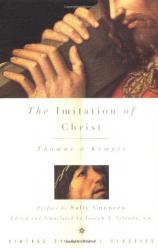Reading Group Guide
Discussion Questions
The Imitation of Christ

1. Like the three previous classics of monastic literature, The Imitation of Christ is a guide to changing our lives and learning to grow closer to Christ in spirit and in deeds. The book opens with a quote and an exhortation: "'Whoever follows Me will not walk in darkness'É.These are Christ's own words by which He exhorts us to imitate His life and His ways" [p. 3]. What does it mean to "follow" Christ in your life? How does Thomas ˆ Kempis approach this task differently from the Desert Fathers, Benedict, and Saint Francis?
2. The injunction that one should "have a humble opinion of one's self" and "love to be unknown and be esteemed as nothing" [pp. 4-5] is quite at odds with the culture of ambition, striving, and success in which we live. What mental and practical conflicts arise when we attempt to live according to this rule? What does Thomas mean when he writes, "He is truly great who is unimportant in his own eyes and considers the greatest of honors a mere nothing"? Is it at all possible to reconcile such teachings with worldly success?
3. Thomas wrote his Imitation for his fellow monks and it is based on the monastic life. How can we who are not living in monasteries, but rather very much in the world, use his precepts to grow closer to God and to attain inner peace? Which of the principles here are easiest to adapt to the busy lives we lead at the end of the 20th century, which most difficult?
4. Like Benedict, Thomas encourages the practice of silence and the setting aside of time for prayer and deep personal reflection [pp. 26-29]. What are the parallels in our contemporary lives to "listening to idle news and gossip" [p. 27]? What time-wasting activities can we learn to do without, in order to make time for solitude and meditation? How does the Christian monastic practice of silence and meditation compare with that of Eastern religions like Buddhism? If you are familiar with "mindfulness meditation" or meditation as practiced by Buddhists, what is similar and what is different between these Asian-based approaches and the Christian monastic approach?
5. Thomas addresses the most difficult question of all, perhaps: that of having the resolve and making the commitment to change our lives: "Come now, and begin this very moment and say to yourself: 'Now is the time to do itÉ.Now is the right time to amend my life'" [p. 32]. How do you respond to such a radical challenge? Do you feel, like Augustine, the desire to be changed, but "not yet" [Confessions, Book VIII]?
6. How can Thomas's advice on living in community and "Bearing with One Another's Failings" [pp. 20-21] be used to better our relationships with those with whom we live and work? What particular insights into human intimacy did you find most useful?
The Imitation of Christ
- Publication Date: March 24, 1998
- Paperback: 288 pages
- Publisher: Vintage
- ISBN-10: 0375700188
- ISBN-13: 9780375700187






